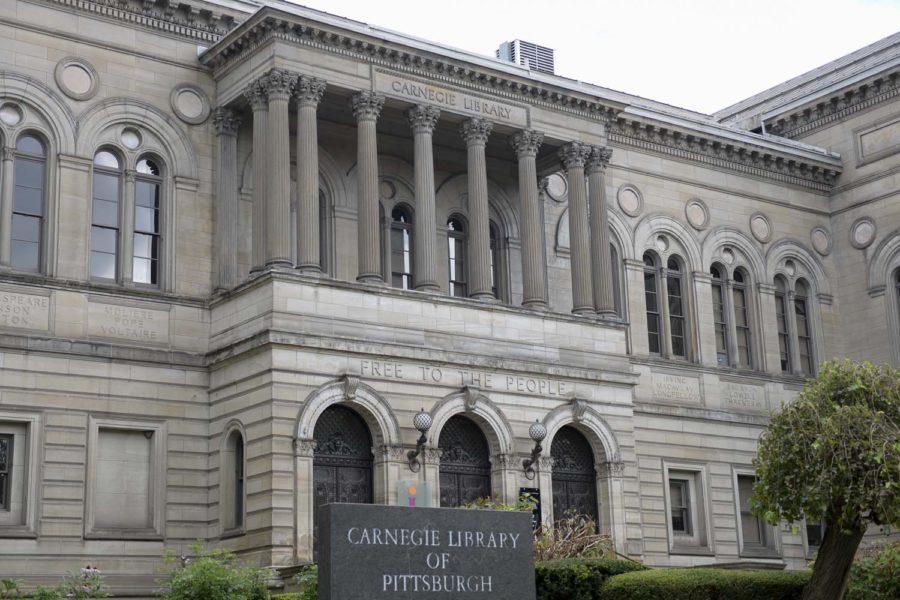Pittsburgh’s Labor Day legacy continues to evolve
Hannah Heisler | Senior Staff Photographer
Carnegie Library workers voted on August 25 to form a union.
September 2, 2019
For the past 37 years, Pittsburgh has hosted the largest Labor Day parade in the United States — Monday’s parade drew an estimated 50,000 marchers Downtown. And Pittsburgh’s rich history of labor strikes and unions is still growing, as library workers, faculty members and even undergraduate students in the area seek union representation.
James Young, an author and a professor of history emeritus at Edinboro University — which has a faculty union — said Pittsburgh has experienced tumults in labor ever since the days of prominent industrialists Andrew Carnegie, Henry Clay Frick and Andrew Mellon.
Pittsburgh is well-known for being the cradle of the labor rights movement of the early 20th century. The Homestead Strike of 1892, when thousands of striking steelworkers at Carnegie Steel Company were eventually violently suppressed by Carnegie, Frick and Pennsylvania state militia, featured one of the first well-organized and purposeful unions that would come to typify labor relations in the 1900s. The American Federation of Labor was created in Pittsburgh in the 1880s, and today, the United Steelworkers, one of the country’s largest trade unions, is still headquartered in the City.
But, Young said, the labor movement didn’t stop with blue-collar workers. As a professor himself, he said he sees the importance of involving academics and professionals in a labor union.
“I’ve heard a lot about how professionals don’t need unions,” Young said. “But you can’t really wear prestige, it’s not that warm.”
Labor unions act as an intermediary between workers and their employers, negotiating for higher pay and benefits. Union membership has been on a downward trend since the 1980s, with about 10% of American workers today represented by a union compared to about 20% in 1983. Ongoing unionization campaigns are working to make that number bigger.
Workers at the University of Pittsburgh Medical Center, the state’s largest employer, are engaged in an ongoing battle to form a union. Union organizers at Pittsburgh’s Carnegie Library have been more successful — last month, workers voted overwhelmingly to form a union through United Steelworkers. More than 300 full- and part-time workers will become part of the union.
Matt Broocke, a Pitt student who interned with the Carnegie Library campaign through the United Steelworkers over the summer, said he hopes the library’s union vote indicates a rise in organized labor among millennials and Gen Zs.
“I feel like it’s normalized that people in our generation are expecting so little of their workplaces that they anticipate little pay, fewer benefits than their parents had,” Broocke, a senior studying political science and Spanish, said. “I see the concept of forming a union as a really good way to counter that and strike back and win back more of what we’ve lost over the past few decades.”
Union approval hit a low a decade ago with the onset of the Great Recession, but Americans are warming to them once again. In a recent Gallup poll, 64% of Americans said they approved of labor unions, one of the highest union approval rates Gallup has recorded in the past 50 years.
Broocke said workers have “so much more power” when they form a united front, adding that unions can build solidarity across different social cleavages.
On Pitt’s campus, the ongoing movements to form unions for faculty and graduate students often provide support for one another. Across the country, graduate student union movements have become increasingly popular — a trend which itself springs from the existence of more faculty unions.
Most graduate student unions formed in the 1990s at public universities. The National Labor Review Board ruled in 2016 that graduate students at private universities are employees, creating a new widespread push for graduate student unions at private universities. According to the Coalition of Graduate Employee Unions, grads from more than two dozen campuses across the country have undertaken the fight for a union.
Hannah Bailey, a Pitt junior majoring in urban studies, said she hopes shifts towards unions in the academic setting will inspire undergraduate student workers to ask for more from their university employers. Bailey said undergrads are often forgotten despite their contributions to the regional economy.
This summer, Bailey worked on a project through the Honors College about the basic needs of undergraduate student workers.
Close to 50% of college students reported experiencing food insecurity in a survey released earlier this year by Temple University’s Hope Center for College, Community and Justice. At Grinnell College, a small liberal arts college in Iowa, student workers have established the country’s first independent undergraduate labor union in the country, demanding wage increases and paid rest breaks.
“Everyone forgets about the undergrads, but many of us are workers too,” Bailey said. “And a lot of us who work are struggling to make ends meet, which means we may not be able to be the kind of students that we, and Pitt, wants us to be.”








